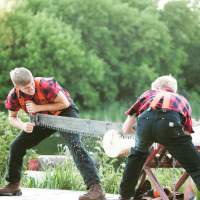Generations of visitors enjoy the authentic Northwoods experience each year. Most families who’ve been coming to the Minocqua area for generations have their favorite haunts. In the case of Norwood Pines Supper Club, that haunt is more literal than figurative. A ghost named Edgar has been haunting the property since there was a bordello above the restaurant, many decades ago. Rumor has it Edgar perished of a broken heart.
Fortunately for present day patrons, romance flourishes at Norwood Pines, whether you dine with a sweetheart or simply love the romance of a vintage Northwoods supper club.
Set on several acres on Patricia Lake just west of Minocqua, the property dates back to the 1930s. It changed hands often over the years, yet no one made a success of it for the long haul, until the Teichmiller brothers bought the place in 1995. Hard to imagine, given the charm of the place — log construction with classic beams overhead, ornate wood trim, a huge stone fireplace and windows that bring the scenic outdoors inside.
Some say it’s because not only is the place haunted but it was cursed by the original owner’s unhappy wife, who didn’t get the property in an acrimonious divorce. Brothers John and Tom Teichmiller aren’t willing to rule out the haunting, but they say the curse has been broken. Given that they’ve done a thriving business since 1995, it seems they speak the truth. They’re the first owners to make it past the 13-year mark.
A menu that mixes supper club staples (a pre-dinner appetizer or relish tray and nightly prime rib) with more contemporary fare (Chef Kurt’s stuffed salmon) — and a legendary assortment of ice cream drinks — appeal to the families who love to make a tradition of dinner or a fish fry at Norwood Pines. And it’s tradition that makes the hard work worth it to John Teichmiller. “It’s a feel-good thing,” he says, “to know we’re providing great memories for a significant number of people who choose Norwood Pines as their favorite family place.”
Norman Rockwell right here in the Northwoods
When 1,200 people show up for a Monday night ball game, it’s noticeable in a town of 1,100. In July and August, it happens weekly in Lake Tomahawk, turning the streets and local ballpark into a scene by Norman Rockwell. There’s no admission fee, not much tailgating and no high stakes riding on the outcome.
Yet families crowd the streets, people greet one another like old friends, and the festive air is palpable. Starting early in the morning — or even the night before — fans reserve their seats by laying blankets on the bleachers (capacity: 800-900), or positioning chairs at the edge of Snowshoe Park.
So what’s the big deal? It depends on whom you ask. Some will tell you it’s the snowshoes. Others will say it’s the pies. A highlight for many spectators is a slice of the 70 to 80 homemade pies sold by area service clubs and community groups. All the groups pitch in every week to provide the pies, and each week, a different organization benefits from the proceeds.
Big sellers are cherry, apple, banana cream, and that summer classic, lemon meringue, “which never lasts more than 30 minutes when it’s available,” says Pat Duncan of the local Lioness Club. Up-to-the-minute flavor availability is tracked on a big dry erase board in the pie tent. The pie concession generally sells out before the game even begins.
This entertaining tradition has a rich history. The Lake Tomahawk Snowhawks played snowshoe baseball on snow in the 1940s and ’50s, and even won a world championship. In 1961 the team began playing on a field of woodchips and sawdust to amuse summer tourists. A tradition was born and Lake Tomahawk claimed its fame as “The Snowshoe Baseball Capital of the World.”
Not Your Grandmother’s Wildlife Park
Minocqua Zoo, Wisconsin’s second largest zoo, is a far cry from its origins as Jim Peck’s Wildwood Kingdom. Hands-on access to animals was paramount for animal lover and wildlife rehabilitator Jim Peck, who founded the park in 1957. That hasn’t changed; Wildwood has what is now the largest petting zoo in the state. As conservation awareness has grown, so have the new owners’ efforts in that direction. The Domaszek family is committed to the preservation and conservation of all animals, and in 2008, the park was granted the prestigious honor of being accredited by the Zoological Association of America.
Here in the park, fun is underscored by education programs and opportunities for animal lovers of all ages. An ambitious master plan ensures thoughtful growth as the park team deepens its commitment to both families and the animals it cares for. As its Vision Statement notes, “Our zoo is a place for guests to spend time with their families, making memories and watching their children learn, laugh and play.”
I can chop faster than you can
Like the majestic white pines they cut down, lumberjacks of yore loom large in our collective memory. The men who lived the rugged, dangerous logging life in the late 18th, early 19th centuries were strong, skilled and competitive. Their work kept them fit and gave them constant opportunity to hone their skills. Occasional sporting contests, coupled with ongoing rivalries, helped them keep their edge and their pride.
Logging has changed, but skills from the heyday of muscle-driven logging remain alive and tested, notably at Fred Scheer’s Lumberjack Show, which has been entertaining families in Woodruff since 1981. Many of the show’s performers are champions who have earned world titles. Take Fred Scheer himself, who seldom performs anymore, but who holds four world titles in logrolling and one world title in the boom run. Log rolling? Boom run? These were important skills back in the day, when logs were moved downriver and someone had to be able to break up log jams and keep logs of many sizes flowing profitably downriver to a mill.
Though much timber came to be moved by rail instead of water, the lumberjacks’ river arts didn’t die out altogether. In lumberjack lingo, the art of keeping your balance on a spinning log was called birling. In the modern-day version of logrolling, two competitors — birlers — vie to be the last one standing, twirling the log with their feet, trying to unbalance one another. In the boom run, two competitors race across the water and back on side-by-side booms — logs chained together end to end — without losing their balance and falling in.
The show mixes speed and skill with gags guaranteed to keep audiences laughing. Many families return year after year and never get tired of the fun. One world titleholder and long-time Scheer’s performer notes, “They love that it’s just the same as they remember it. They walk out with smiles on their faces after every single show.”
Rise and Shine
The skill wasn’t the only thing legendary about lumberjacks. Their appetites were as big as their reputations. Today, just having fun in the Northwoods can stir up a hefty appetite, and where better to satisfy it than Paul Bunyan’s Cook Shanty. A 36-foot statue of Paul and Babe, his blue ox, stands outside the Cook Shanty to greet hungry families. Inside the log beam building, large historic photos bring logging camps to life, and artifacts from Wisconsin’s logging heyday add to the charm.
Food is served family-style, as it was in real logging camps. The all-you-can-eat portions may not be quite so massive, but they’re still ample for the most demanding of appetites. And yes, individual platters are an option for the faint of heart. For more than half a century, Paul Bunyan’s in-house bakery has been making homemade treats. Don’t miss their scrumptious doughnuts or Paul Bunyan-sized cookies!
Aquatic Antics
Combine daredevil acrobatics with a happy-go-lucky, not-a-care-in-the-world, totally-in-love-with-summer spirit. Throw in a little poetry in motion, add a dash or two of romance. Color it with hot-dogging fun and you begin to get what the Min-Aqua Bats Water Ski Club is all about.
The club was launched in 1950, making it among the oldest amateur water ski clubs in the country. By 1952 they were chartered and had raised enough money to buy the club’s first ski boat. Funds come from sponsorships, ‘passing the bucket’ at shows, and concession stand sales.
The 50 or so muscled athletes who make up the club train hard for their thrice-weekly shows at Minocqua’s Aqua Bowl, playing to audience members from around the world. Club members come from as near as Woodruff and as far away as Mexico and Hawaii, and many are so skilled they go on to perform professionally.
The club performs in shows and tournaments throughout the Midwest and club members have won many awards in state, regional and national competitions. It’s no wonder that for decades, they’ve been a staple of summer fun in Minocqua.
The Min-Aqua Bats perform throughout the summer at 7 p.m. on Friday, Sunday and Wednesday evenings in the Aqua Bowl, located along Park Avenue, just northwest of the Highway 51 bridge over Lake Minocqua. Shows are free and open to the public, as they have been since the club’s inception.
When day is done
There’s something about the Northwoods air that promises great sleeping — and when you’re booked into Dillman’s Bay Resort on White Sand Lake, you get a lot more than a restful night’s sleep. This classic Northwoods resort is situated on a peninsula with four beaches and a marina. When you’ve had enough water sport for one day, you can get out on the tennis courts, take the kids to an onsite playground or simply stroll the scenic grounds.
There’s a commitment to showing guests a good time here, not surprising since the resort has been in the Dillman family since the 1930s. Of special note is Dillman’s Creative Arts Program, launched more than 30 years ago, through which acclaimed instructors offer classes in two-dimensional arts, wood and gem carving, and more.
Though some 80 years have passed since the resort first opened, and many upgrades have improved the guest experience, the place doesn’t look or feel much different than it did when earlier generations came north for the same relaxing and iconic experience Dillman’s delivers today.










